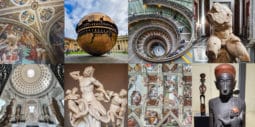

989269 travellers read
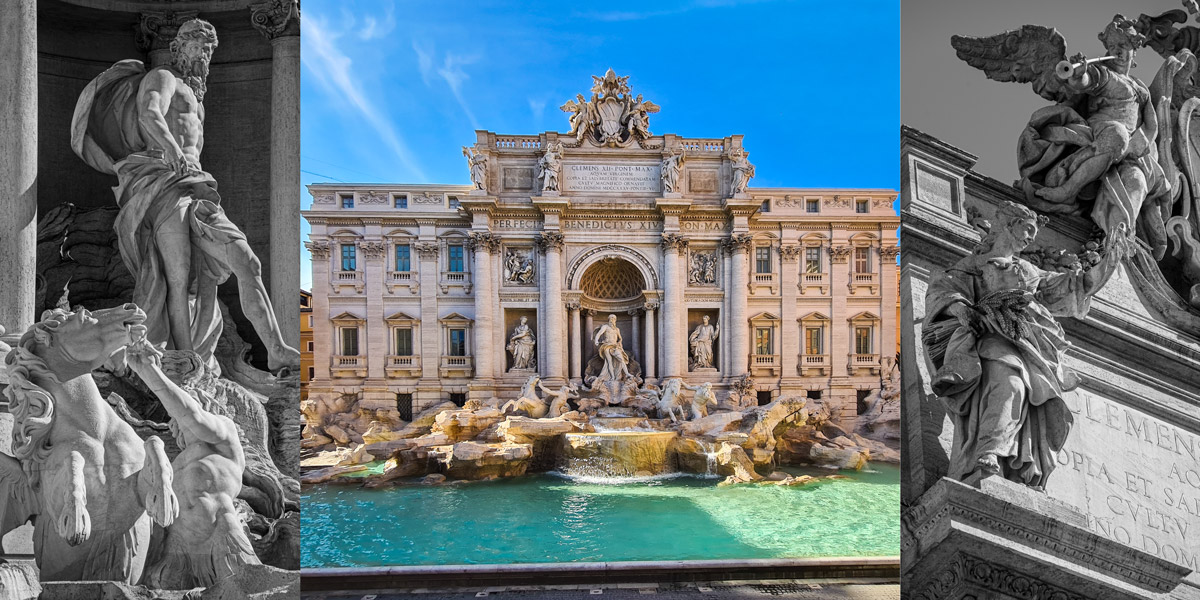
| Tip | Visit the Trevi Fountain early in the morning or later in the evening to avoid the busiest times. Take part in the iconic coin-tossing tradition—but do note that entering the water is strictly prohibited. Wander the surrounding streets and enjoy a coffee or gelato at one of the nearby cafés for a truly memorable Roman experience. |
|---|---|
| Recommended tour | |
| Closest bus stops |
|
| Closest subway stations |
|
| Address | Piazza di Trevi, Roma |
| Website | www.turismoroma.it |
The Trevi Fountain (Italian: Fontana di Trevi) is Rome’s most iconic Baroque masterpiece, a true gem among the city’s many fountains. Majestic and theatrical, it resembles an ancient drama sculpted in stone rather than a simple water source. Owing to its grand scale, central location, and striking beauty, the fountain attracts millions of visitors to the Italian capital each year.
Contents
ToggleTo truly appreciate the grandeur of the Trevi Fountain, it’s worth delving into the symbolism behind each exquisitely carved figure and decorative element. This step-by-step guide, moving from top to bottom, reveals the rich stories and artistic intentions embedded in the fountain’s design—adding depth and meaning to your visit.
Use this guide while standing before the Trevi Fountain to connect more profoundly with its artistry and enduring legends.
At the very top of the fountain, you’ll see a grand sculptural group crowned by the unmistakable Papal Tiara, a traditional symbol of the Pope’s supreme authority. Just below it are two crossed keys representing Saint Peter’s keys to Heaven—another powerful emblem of papal influence.
Interestingly, the central shield does not feature a detailed coat of arms, hinting at the fountain’s broader significance—it is a monument for all Romans, not merely a tribute to one particular pontiff.
On either side of the shield, two angels blow trumpets, symbolising Fame and heralding Pope Clement XII, who commissioned the construction of the fountain. These dynamic figures, sculpted by Paolo Benaglia, are a striking example of Baroque artistry, full of movement and theatrical flair.
Just beneath the Papal Tiara is a prominent Latin inscription that commemorates Pope Clement XII’s patronage of the fountain:
CLEMENS XII PONT. MAX. AQUAM VIRGINEM COPIA ET SALUBRITATE COMMENDATAM CULTU MAGNIFICO ORNAVIT ANNO DOMINI MDCCXXXV PONTIF. VI
Translated, this reads:
“Clement XII, Supreme Pontiff, adorned the Aqua Virgo—praised for its abundance and healthfulness—with magnificent decoration, in the year of the Lord 1735, the sixth year of his pontificate.”
Four allegorical statues surround the inscription, each sculpted by Andrea Bergondi, representing virtues associated with Rome:
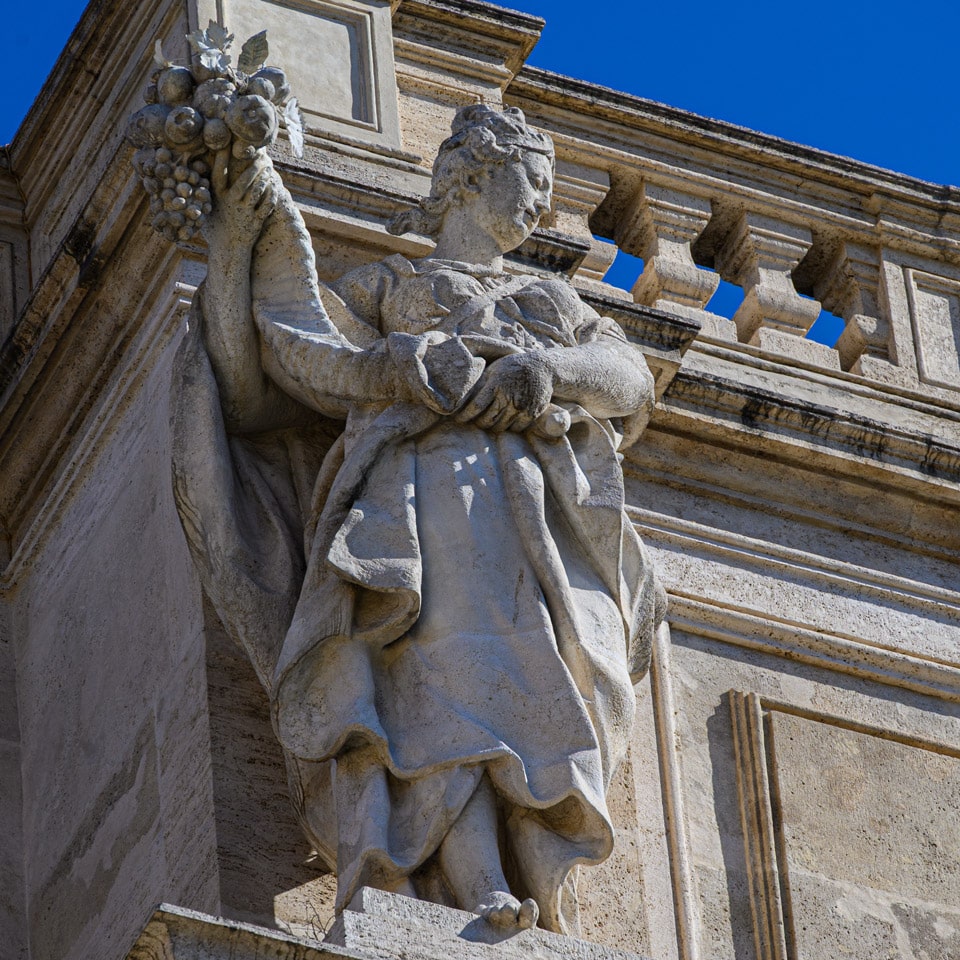
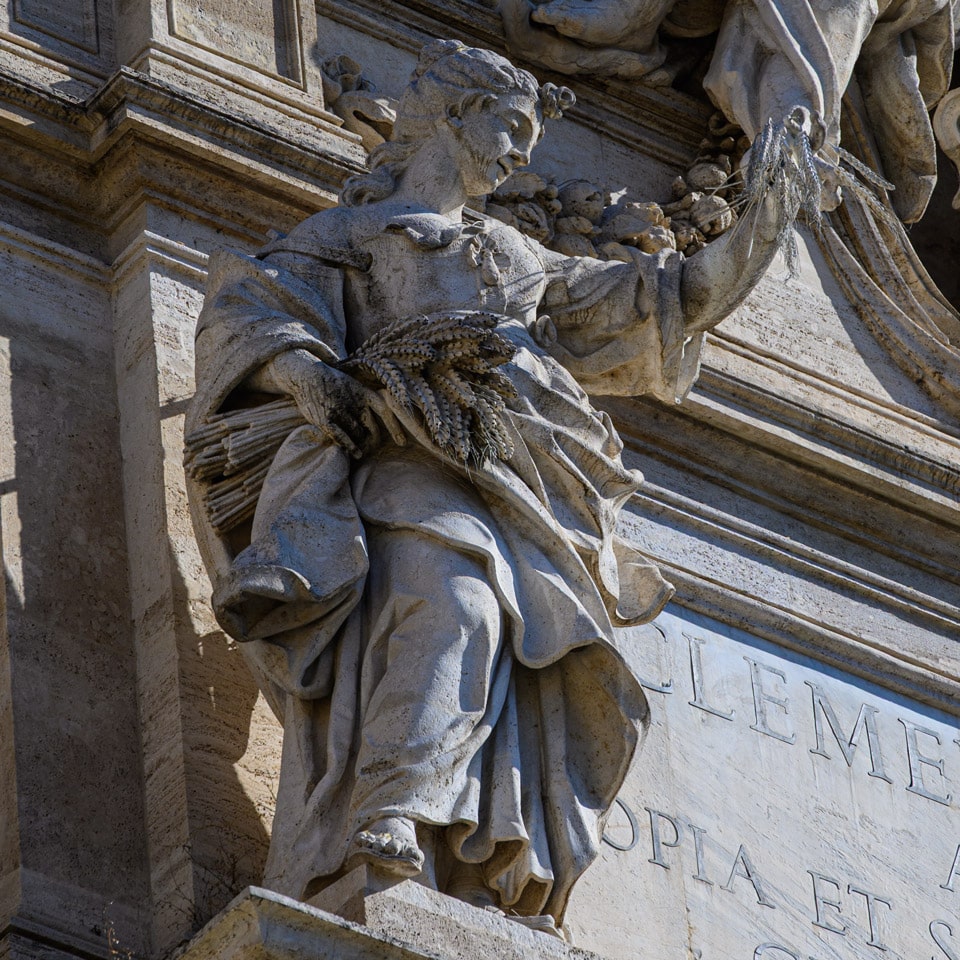
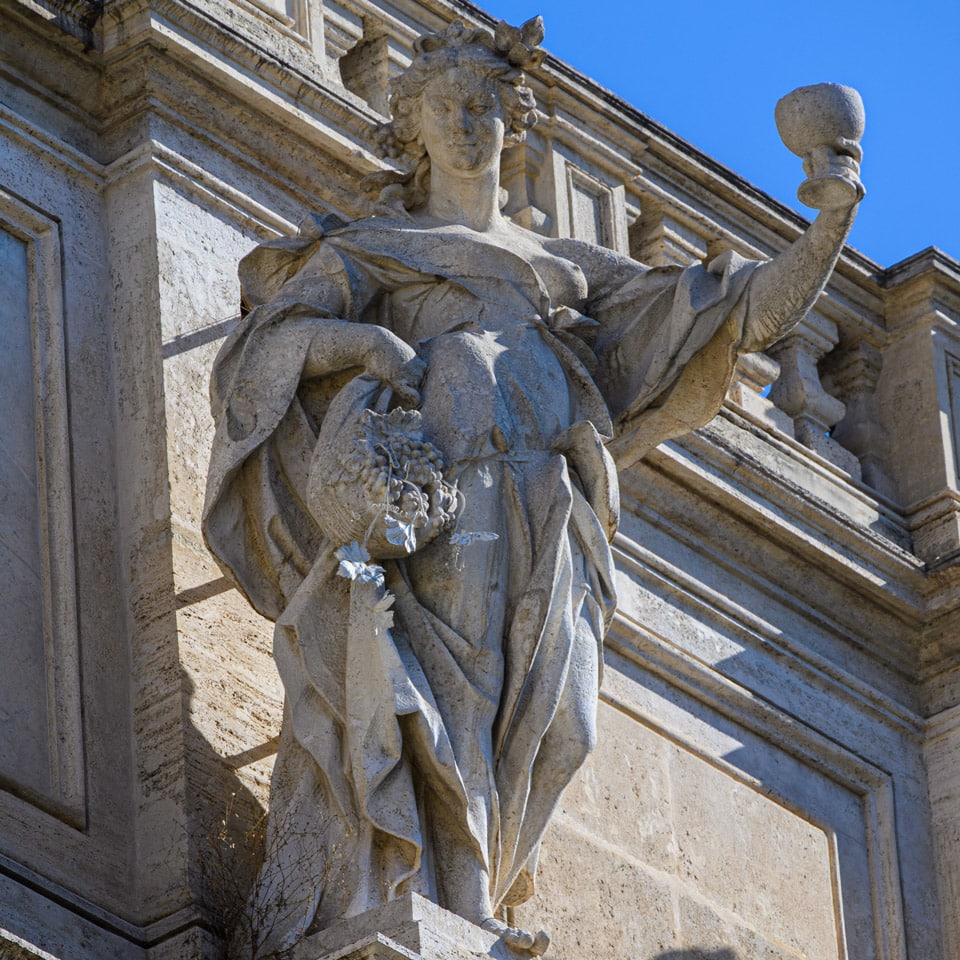
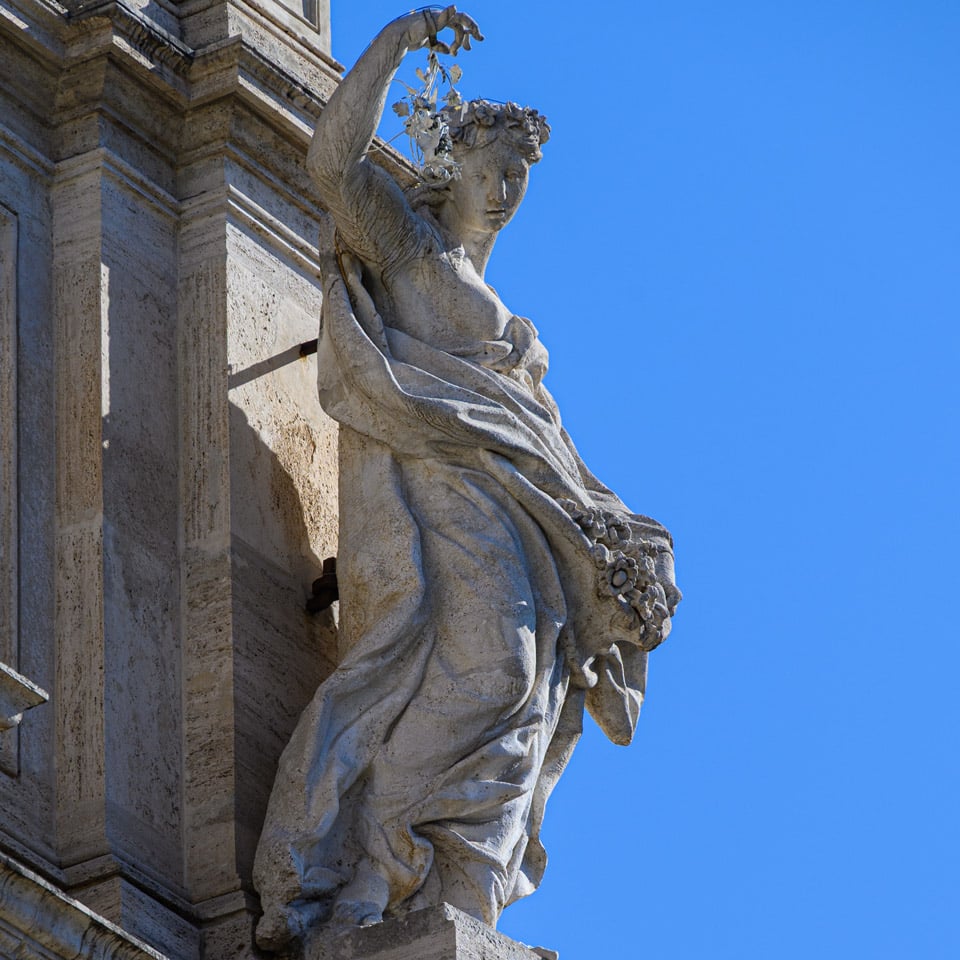
Together, these figures celebrate the life-giving benefits of the Aqua Virgo aqueduct, which has supplied fresh water to Rome since ancient times.
Beneath Clement XII’s inscription is a second Latin dedication, honouring the pope who brought the project to completion:
PERFECIT BENEDICTUS XIV PON. MAX.
Translated, it means:
“Benedict XIV, Supreme Pontiff, completed this work.”
Following Clement XII’s death, Pope Benedict XIV ensured that construction and funding continued, bringing this remarkable monument to its final form.
On the left, a detailed bas-relief sculpted by Giovan Battista Grossi captures General Agrippa approving plans for the Aqua Virgo aqueduct in 19 BC. Agrippa confidently examines plans presented by an engineer, symbolizing Rome’s ambitious engineering achievements.
On the right-hand side, a bas-relief by Andrea Bergondi depicts the legendary moment when a young maiden (“virgo”) guided Roman soldiers to a pure spring, marking the mythical origin of the aqueduct and giving it its name, *Aqua Virgo*.
At the heart of the fountain stands Oceanus, a powerful Titan god representing all the world’s oceans.
He rides a shell-shaped chariot drawn by two seahorses—one calm, the other wild—each led by a Triton, symbolising the contrasting temperaments of the sea. Sculpted by Pietro Bracci, this dynamic scene captures the expressive spirit of the Baroque style.
Above Oceanus, a Latin inscription reads:
POSITIS SIGNIS ET ANAGLYPHIS TABULIS IUSSU CLEMENTIS XIII PONT. MAX. OPUS CUM OMNI CULTU ABSOLUTUM A.D. MDCCLXII
Translated, it states:
“The statues and reliefs having been placed, the work was completed by order of Clement XIII, Supreme Pontiff, in the year of the Lord 1762.”
To Oceanus’s left is Abbondanza, the Goddess of Abundance, sculpted by Filippo della Valle. She gently holds a cornucopia, symbolising the prosperity and nourishment brought to Rome through the aqueduct.
At the centre of the fountain, Oceanus is depicted stepping forward with commanding presence—symbolising the immense power and life-giving force of water.
Opposite Abbondanza, also by Filippo della Valle, stands Salubrità, the Goddess of Health. She holds a spear and a bowl from which a snake drinks—an ancient symbol of healing—representing the purity and restorative power of the fountain’s waters.
Beneath Oceanus, on the left, a powerful Triton wrestles with a wild seahorse, symbolising the stormy and unpredictable nature of the sea—another dramatic composition by Pietro Bracci.
On the right, a more composed Triton blows a conch shell, guiding a calm seahorse—representing the ocean’s serene and life-sustaining character. This elegant contrast captures the dual essence of the sea.
Together, these figures form a harmonious tribute to Rome’s connection with water, showcasing both its strength and splendour. The Trevi Fountain brings history, mythology, and artistic expression vividly to life in one of the city’s most celebrated monuments.
Constructed in the 18th century, the Trevi Fountain has a fascinating history that dates back to the days of ancient Rome. Its roots can be traced to around 19 BC, during the reign of Emperor Augustus, when Marcus Vipsanius Agrippa, his trusted advisor, undertook a major reorganisation of Rome’s water supply. Among his key achievements was the construction of the Aqua Virgo aqueduct, designed to provide the city’s population with fresh drinking water.
The Aqua Virgo—so named for the purity of its water—extended for approximately 12 kilometres (around 7.5 miles), serving the citizens of ancient Rome for centuries.
Until the early 17th century, visitors to Piazza di Trevi could still drink from a simple spring that flowed into a stone basin. Pope Urban VIII believed the city deserved something more magnificent and commissioned the renowned Baroque architect Gian Lorenzo Bernini to design a fittingly grand fountain for the square.
The original design of the fountain was conceived by the celebrated artist Gian Lorenzo Bernini. However, following the death of Pope Urban VIII in 1644, the project was suspended, and Bernini’s plans were never realised. It was not until the early 18th century that the idea was revived under Bernini’s pupil, Carlo Fontana. Fontana retained the essence of Bernini’s Baroque vision while incorporating classical elements, emphasising proportion and harmony.
His updated design placed a grand sculpture of Oceanus—often mistaken for Neptune—at its centre, accompanied by Tritons and mythical sea creatures symbolising the ocean’s might.
After Fontana’s death in 1714, the project was again delayed. It wasn’t until 1730 that Pope Clement XII organised a prestigious competition to appoint a new chief architect. Nicola Salvi triumphed over fifteen other renowned contenders, winning the opportunity to create a breathtaking masterpiece that would both amaze visitors and complement the architecture of Trevi Square.
Salvi was tasked with creating a fountain that was not only monumental and visually captivating but also harmoniously integrated into the façade of the Palazzo Poli. His bold and imaginative design came to life in a spectacular display of Baroque artistry—cementing the Trevi Fountain’s place as one of Rome’s most iconic landmarks.
Standing in Piazza di Trevi today, visitors may not immediately realise that the Palazzo Poli and the Trevi Fountain form a single, unified architectural composition. Architect Nicola Salvi skilfully integrated the two, creating a striking arrangement of dynamic sculptures that continue to enchant visitors centuries later.
The Trevi Fountain took 30 years to complete—from 1732 to 1762. By the time it was finished, an awe-inspiring scene of Oceanus emerging dramatically from the water had taken shape against the Baroque façade of Palazzo Poli. Salvi’s design captures energy and movement so vividly that it’s easy to imagine Oceanus’s chariot surging forward through waves and spray.
Today, visitors from across the globe come to admire Rome’s most famous fountain and to take part in a much-loved tradition: tossing coins into its waters.
According to tradition, tossing coins into the fountain brings different blessings:
To make your wish properly, stand with your back to the fountain and toss your coin using your right hand over your left shoulder.
The coins tossed each day quickly add up. On average, visitors contribute around €1,500 daily—totalling over €1 million every year. The collected money is donated to Caritas Roma, a charitable organisation supporting those in need throughout the city.
To witness a fascinating part of the fountain’s maintenance, visit early on Monday mornings (around 08:00).
At this time, city workers drain and gently clean the fountain, collecting the thousands of coins left by hopeful visitors during the week.
Watching this careful process offers a rare behind-the-scenes look at how Rome preserves one of its most treasured landmarks.
The name “Trevi Fountain” has inspired a number of fascinating legends and interpretations. The most widely accepted explanation connects the name to its location at the junction of three major Roman streets. Indeed, scholars agree that the Italian word trevi is derived from the Latin trivium, meaning “a meeting point of three roads.”
A charming alternative tale tells of a young woman named Trivia, who is said to have guided ancient Roman builders to a hidden spring of remarkably pure water. This spring later supplied the Aqua Virgo aqueduct, which in turn feeds the fountain.
From June 2014 to November 2015, the Trevi Fountain was officially closed to visitors due to essential restoration works. The fountain’s stone structures had suffered considerable deterioration—worn down by constant water flow and the daily pressure of heavy foot traffic. Remarkably, the last major renovation had taken place over 125 years earlier. By 2014, damage to some of the sculptures had become so severe that parts began to detach, prompting urgent emergency repairs.
The fashion house Fendi took a special interest in restoring this iconic monument. The estimated cost of the renovation reached approximately €2.2 million, generously funded by the brand.
See our travel tips for What to See in 3 Days and the Top 15 Free Things to Do in Rome.
Accommodation with direct views of the Trevi Fountain is limited, in high demand, and tends to book out well in advance—particularly during peak tourist seasons. If you dream of waking up to the sight of the fountain just outside your window, it’s highly advisable to reserve early.
Here are three top-rated options offering unforgettable views:
The distance from the Spanish Steps to the Trevi Fountain is just 650 metres (0.4 miles), making it an easy 8-minute walk.
As a local expert, I recommend a more scenic and self-guided sightseeing route:
This richly informative and scenic walk is just 1.5 miles (2.4 km). Allow about 1 hour to complete the route, including time for visiting churches and taking photos.
The Trevi Fountain lies in the Trevi district, while the Colosseum is in the Monti area. The direct distance is approximately 1 mile (1.6 km), taking around 20 minutes on foot.
For a more enriching experience, follow this self-guided sightseeing route:
This walking route is 3.3 miles (5.3 km) long. With stops for sightseeing, the full experience takes approximately 2 hours.
If you’re interested in a private tour or would like help planning your holiday, please get in touch via the contact form.
Wishing you a wonderful visit to Rome!
Author: Artur Jakucewicz
This website uses cookies. For more info read the cookies policy
RomeItaly.guide © 2025. Created with love by Roman experts and guides.